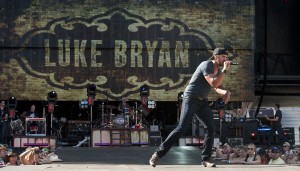Saturday, Luke Bryan added a verse and chorus of Metallica’s “Enter Sandman” to his own “All My Friends Say,” complete with a credible, sledgehammer-heavy intro. It was something he said he had to do in Death Valley, but it also made a statement that was made again and again at Tiger Stadium in Baton Rouge at Bayou Country Superfest. Country music has not only evolved into something that Waylon Jennings wouldn’t recognize, but it’s something that would even make Garth Brooks and Alan Jackson scratch their heads.
Appropriately, Bryan looked more like he might have just taken off the pads a year or so ago, athletic with a dark green t-shirt and instead of a cowboy hat he wore a baseball cap that he frequently turned backwards. His set provided a sort of baseline for the day with songs that were not quite suburban but certainly not rural, not small town but definitely not urban. They were songs populated by and written for people who lived close enough to the country to be nostalgic for the good times there and the values system implied by that connection, but city enough to be excited by the Bon Jovi-like talk box at the start of “Country Girl (Shake it for Me).”
“Country” has become a concept more than a style, and the music between Bryan and Trace Adkins’ set helped illuminate it. Instead of country music of some vintage, the sounds of Tom Petty and John Mellencamp among others filled Tiger Stadium, and the world of country music today is the world of Bob Seger’s Night Moves or Mellencamp’s Uh Huh. It’s not the music of the working class as much as it is the music of people who work, which includes white and blue collar jobs, and it’s the music of domesticity. That it has in common with traditional country, but more than being about family structures, that thread feels like it’s emphasized to mark the music as being in opposition to the seemingly rootless people who like indie rock and electronica.
Trace Adkins wore a black hat, black t-shirt and long ponytail, looking like an outlaw and moving around the stage as if any concession to entertainment values might cost him his Harley. Musically, though, his sound had the sheer guitar density and crunch of Aerosmith and classic hard rock bands, but a good indication of the current state of country music came during “Hot Mama.” In it, he celebrates the wife of his kids, and how she still turns him on. Live, this moment was augmented by the song’s video on the screen behind him, which put the song in a context with Warrant’s “Cherry Pie” and other hair metal videos that drool over the sexy model.
[youtube]http://www.youtube.com/watch?v=qNPEbHoCxNg[/youtube]
Adkins does, however, get traditional country points for using the phrase “honky tonk,” even if it was in “Honky Tonk Badonkadonk,” a funk-rock track that even includes programmed drums on the recorded version. Honky tonks were in short supply Saturday night.
[youtube]http://www.youtube.com/watch?v=vNVguvNE7qc[/youtube]
The between-set music before Sugarland was even farther from traditional country: R.E.M., the Police, Duran Duran and U2 among others. Then again, Jennifer Nettles and Kristian Bush come out of Atlanta’s rock and folk scenes, not from Nashville or country, and if it weren’t for Nettles’ intense, perhaps theatrical twang, much of the band’s set would have simply sounded like the product of a good pop-rock band. Their songs were from the same social place as Adkins’ but pitched slightly younger and definitely female. Not quite the Battle Hymn of the Soccer Mom, more Sex and the City for women with small cities or big towns instead of the Big Apple. Their nod to country came when they worked a Better Than Ezra-like medley of favorite songs into “Everyday America,” singing a snippet of Britney’s “Oops, I Did It Again,” Cee Lo Green’s “Forget You,” “Bootylicious” and Dolly Parton’s “9 to 5″—(hardly Dolly’s most country song, but more classically country than anything else in their set).
[youtube]http://www.youtube.com/watch?v=Hyidx_U9k6E[/youtube]
When Tim McGraw’s stage set was revealed, it had a lot in common with Eminem’s stage at Voodoo in 2009, with a video screen overhead and geometric risers for band members with lights and video on the front facing. When he sang “Stars Go Blue,” he only had to make a few cosmetic changes to convert it to aBreakfast Club-era new wave pop ballad. Luke Bryan never seemed to have more fun than when he was presiding over his band during the pounding, building intro to “Enter Sandman.” It should be noted, though, that no one in the crowd around me was put out by all of this in the least, which suggests some interesting possibilities. One is that genre labels don’t matter, but that’s not right. I don’t think audiences divide neatly into genre-based markets, but too many people at the festival took being country boys and country girls as parts of their identities for the labels to be irrelevant. More likely, the degree to which country has come to emulate rock in so many significant ways speaks to the power of rock ‘n’ roll, how thoroughly it has shaped America’s musical imagination and the language of popular music.





